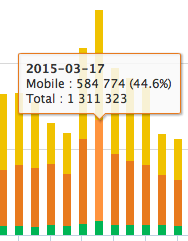Google’s mobile-friendly algorithm update was rolled out April 21 in an attempt to improve the mobile user’s search and internet experiences. The update didn’t come as much of a surprise, as Google issued warnings 2 months prior to the update and industry experts had been chanting the mantra, “optimize for mobile” for some time before that. Still, the actual event was billed as “mobilegeddon” by some and predictions about the severe impact on businesses were rampant.
Since then, the post-apocalypitc coverage has continued with warnings and advice. Despite the depth and breadth of coverage, we’re still getting plenty of questions from our customers who may be reading articles with conflicting information. To address these issues and answer some commonly asked questions from marketers and agencies, I spoke with Ray Grieselhuber, Founder & CEO at GinzaMetrics to get his take on the mobile-friendly environment.
Mobile-Friendly, Mobile-Visible, or Fully Optimized?
 Most the people who have been following this change closely are SEO practitioners who probably have a pretty good idea what the changes are, but there are a lot of marketers, content creators, and others who have been on the fringe and may not be as up to speed on what the changes are and what their impact has been. For all of us, here’s a recap. Let’s start with a few of the terms:
Most the people who have been following this change closely are SEO practitioners who probably have a pretty good idea what the changes are, but there are a lot of marketers, content creators, and others who have been on the fringe and may not be as up to speed on what the changes are and what their impact has been. For all of us, here’s a recap. Let’s start with a few of the terms:
Mobile-visible
A mobile-visible site is one that can be viewed even if it’s not specifically optimized for mobile devices, like your iphone or tablet. Most of the sites in the early days were mobile visible. Today, a vast majority of sites out there would still fit in the mobile-visible category.
Mobile-Friendly
The mobile-friendly sites are the ones that Google’s algorithm was updated to address. Mobile-friendly basically includes sites that are on the path to full optimization. Some of them will be fully optimized. Others may think they’re fully-optimized, but may not be competely optimized. These sites are still doing a decent job of mobile usability and utilize veiwport, resizing, and other mobile-friendly features.
Fully Mobile-Optimized
Fully mobile-optimized sites are those sites that are probably developed by people who are experts in website development and who have created a seamless experience for mobile users. These sites are responsive to all the different types of touch events and everything within the site works flawlessly. Fully mobile-optimized is the ultimate goal of site development and also a process that will take a few years for most brands to completely master.
“This recent Google algorithm was designed to promote in the search rankings those sites that are more mobile-friendly. Mobile-visible sites weren’t as badly hit as some people were predicting, but there’s definitely a change now in mentality and also in the way that some of these rankings are handled to prefer mobile-friendly sites,” states Ray.
Mobilegeddon or Just an SEO Shakeup?
 Despite the ominous predictions, the shift to mobile-friendly is going to be a gradual process. Although people were expecting a much bigger impact overall, the actual event impacted about 20 to 30 percent of sites/pages.
Despite the ominous predictions, the shift to mobile-friendly is going to be a gradual process. Although people were expecting a much bigger impact overall, the actual event impacted about 20 to 30 percent of sites/pages.
“I think this is a gradual process,”states Ray, “When Google starts trying to nudge webmasters in the direction of changes that are fundamental changes to their infrastructure, and to the way they publish content and everything else, they know better than to try to force everything to happen with one single algorithm change. I think we’re going to be seeing rolling updates of these over the next three or four years and it’s going to become more and more of a requirement to have not only mobile-friendly sites, but mobile-optimized sites as things progress.”
That’s not to say there was no impact from the changes, but the impact was moderate, not apocalyptic. The news headlines were not filled with stories of companies going out of business, or even very many losing much traffic, due to the change. One of the reasons the impact was smaller than predicted may be that only a small percentage of sites out there are truly optimized for mobile. If Google punished every site catastrophically that was not optimized for mobile, there wouldn’t be any internet to show in the search engine rankings.
At some point, there’s a diminishing return of what sort of changes Google can expect to achieve with this algorithm, right now. Without taking other factors into consideration, Google could end up promoting lower quality content that just happens to be optimized for mobile and end-user search results would actually suffer.
“It all needs to be taken into context of what Google’s goal is,” comments Ray. “The goal is to promote higher quality content overall. As long as your content is visible and usable on a mobile device and it’s the hightest quality, then there’s a good chance – not a guarantee – but a good chance that you’re still going to be ranking well.”
Although the bar has been set pretty low for what is considered mobile friendly right now, that standard is going to be raised over time. Before April 21, there were predictions that 50 percent of Fortune 500 companies would be impacted, and while those predictions are probably right, it’s important to consider what it might mean to be affected. Because of how the algorithm is deployed, the affect is focused on individual pages more than overall websites. For large companies, especially the Fortune 500, you could be talking about hundreds of websites and different domains. When you’re talking that kind of scale, you can assume that some of the properties were affected and some weren’t. Whether pages on your website were affected or not, the take-away here is to concentrate your efforts on high-quality content moving forward to maintain your ranking positions.
Mobile Friendly Marketing
If the majority of searches are happening on mobile, then mobile is the primary screen for marketers. Although creating content for mobile is not going to be a completely new process, there are some things marketers should consider moving forward.
A good place to start is the blog, since this is a place where marketers may have more control than other parts of the website. Given the current drive toward mobile-friendly pages, should marketers abandon the practice of creating more long-form content in favor of the more easily digestible short blog posts? The answer isn’t clear just yet. But, the reason long-form worked in the first place is that it’s a good indicator of quality overall. You just can’t really delve into a topic in less than 1,000 words. Google is still looking for quality and recognizes that length and depth of sentence structure are still useful indicators of quality in a lot of ways.
“One trend that hasn’t really been tested is the practice of finding long content on your phone and bookmarking it or forwarding it to yourself to read later on a PC or tablet,” notes Ray. “Another trend is content sharing. A short piece of content that’s punchy may get shared more often and would likely show up in the algorithm as a quality piece of content.”
For now, marketers should focus on producing quality content, whether that’s long or short form. Best writing practices and content that is well-abbreviated, well-spaced, well paced, and focused on a target audience will continue to rank well in the long-term.
The challenge for marketers will be to measure their impact on all marketing channels and to compare desktop and laptop trafffic to mobile traffic. If more than 40% of your traffic is coming from smartphones, it’s time to focus your efforts on that audience. Discover their unique habits and the keywords they search for when on their phones. Once you know your audience, target your content to fit their needs and their lifestyles.
A New Conversation: Marketing and IT
 In some organizations, marketing and IT may be at odds with each other because marketing needs much more rapid innovation than IT teams are able to provide. Getting the brand websites optimized for mobile may be one of those areas where marketing and IT can begin to work together. While there is definitely a content component, website optimization is also very technical. This is a good opportunity for marketing teams and technical teams to sit down and divide up the work, where it makes sense, and for everyone to work together to get fully optimized. Take this opportunity to build strategies for these two groups to work together.
In some organizations, marketing and IT may be at odds with each other because marketing needs much more rapid innovation than IT teams are able to provide. Getting the brand websites optimized for mobile may be one of those areas where marketing and IT can begin to work together. While there is definitely a content component, website optimization is also very technical. This is a good opportunity for marketing teams and technical teams to sit down and divide up the work, where it makes sense, and for everyone to work together to get fully optimized. Take this opportunity to build strategies for these two groups to work together.
“This is where I would say marketing teams and technology teams need to work together to create a strategy,” recommends Ray. “Marketing teams should be focused on optimizing content, both creating new content and optimizing old content. They should be pushing very heavily to the technology teams to actually get the site-wide optimization for mobile underway now, because it’s going to continue to change.”
Now that the algorithm has been unleashed, people are wanting to know what the impact will be moving forward. While no-one knows exactly when Google will be updating the mobile-friendly update again, there are some ways to monitor your own results to identify algorithm changes. Brands can monitor subtle and large changes in their search results by expanding their use of marketing intelliegence data. Here are some things you’ll want to do:
- Increase the breadth of the type of tracking to include device and search engine results
- Pay more attention to competitor discovery and competitor ranking
- Stay up to date with the industry news on this subject
- Track your rankings on a daily basis to watch for subtle algorithm changes
If you need help with getting your marketing intelligence up to speed, give us a shout. Let us know how you’ve been affected by the recent changes and any insights you may have that you’d like to share. Contact us if you have any questions that we haven’t answered here.
Stay up to date on our latest news: subscribe to our monthly newsletter: FOUND.

